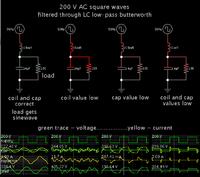jonnybgood
Full Member level 4

If I had to consider a positive square wave of a certain amplitude it's DC equivalent would be the amplitude divided by 2.
Now if I were to pass it through a 2nd order high pass filter where I know the two poles (ex 50Hz, 200Hz), what is the best way to calculate the DC equivalent of the filtered output.
my try;
-The square wave is made up of odd harmonics;
- Can I take harmonics from a pole onwards and attenuate them accordingly by 20/40dB slope ?
What is the best way to test my answers in simulation?
Now if I were to pass it through a 2nd order high pass filter where I know the two poles (ex 50Hz, 200Hz), what is the best way to calculate the DC equivalent of the filtered output.
my try;
-The square wave is made up of odd harmonics;
- Can I take harmonics from a pole onwards and attenuate them accordingly by 20/40dB slope ?
What is the best way to test my answers in simulation?

